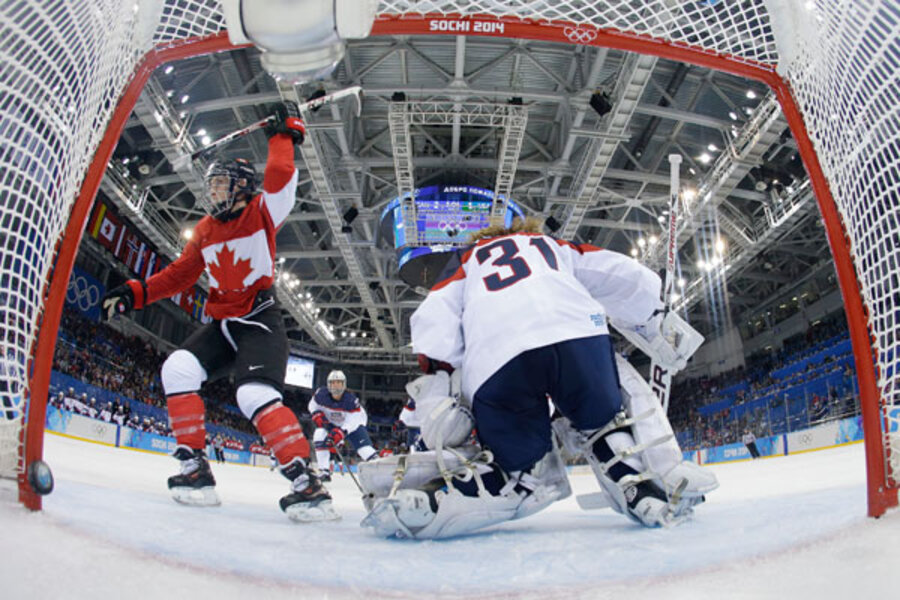Women's Olympic hockey: Canada tops USA, but are both still too good?
Loading...
| Sochi, Russia
Once again, as anyone could have predicted, the women of the United States and Canada played a wonderfully entertaining game of hockey Wednesday afternoon at the Olympics, with Canada scratching out a hard-fought 3-2 preliminary round victory.
That's the bad news.
The fact is, the United States and Canada really only get a good game when they play against each other. The other games are mostly a matter of moral victories for their opponents. When Finland lost to the US, 3-1, earlier in the tournament, it took pride in "winning" the third period, 1-0.
Women's hockey's apparent lack of progress toward becoming more than a two-team sport has been a hot topic at the Sochi Olympics. While women's soccer has become vibrant and varied, with the 2012 Olympic tournament showing how far the sport has progressed, the Sochi Olympics have so far seemed only to underline old stereotypes about women's hockey.
In 2010, then-International Olympic Committee President Jacques Rogge said in Vancouver, "We cannot continue without improvement." That comment, echoing into this Olympics, with the USA's 9-0 demolition of Switzerland, has forced the IOC to come out and specifically refute rumors that women's hockey could be on its way out of the Winter Games.
"We are supportive. There have been some very good matches, and we are very pleased," IOC spokesman Mark Adams said Wednesday.
On one hand, that is a matter of interpretation. Sochi has avoided the lopsided 18-0 and 13-0 scores put up by Canada and the US in Vancouver largely by smoke and mirrors. It has put the four worst teams in Group B – meaning they'll never play Canada or the US, who are in Group A. If that sounds odd, it is. The top four teams in Group A will all qualify for the knockout round, regardless of record, while only two will qualify from Group B.
With the top two teams from Group A (almost certain to be Canada and the US) getting a bye into the semifinals, neither will likely ever play a Group B team in Sochi. That's not improvement, that's a quarantine.
Moreover, the clear No. 3 team in world hockey, Finland, still looks like it's hanging off a cliff by its fingernails any time it plays the US or Canada. Occasionally, it has won, as can sometimes happen in hockey. Finland happens to have perhaps the best goalie in the world in Noora Raty, and when it beat the US in November, Raty summarized the game thus to the Los Angeles Times: "At one point I was kind of laughing, 'How am I making all these saves?' "
In Saturday's 3-1 loss to the US, the No. 3 team in the world was outshot 43-15.
Yet the IOC's Adams is not entirely living in a world of rose-colored ice. There is progress. In Group B, Japan has put together a system with an aggressive forecheck to disrupt opponents in their defensive zone. Russian skaters twirl inside their offensive end like their famous brethren, giving a hint of what could be. The traces of what a global game could be are there, if dim.
The problem is that all progress is being measured against the yardstick of Canada and the US, and they keep moving the bar. Raty, who practices against Finnish National Hockey League players, says the USA's Hilary Knight has a wrist shot as hard as any.
The US and Canada are pushing the sport in new directions, with Canada playing a physical, puck-possession style of game while the US counters with speed and puck pursuit. And the other countries are having trouble keeping up.
In an attempt to help their opponents get better, the Canada and the US have begun sending coaches and players to run camps for other teams, sharing ideas about conditioning, training, and nutrition. They come back with stories of women passionate about the game but with limited opportunity to turn that passion into progress.
"We learned how difficult it is for some countries," said Jessie Vetter at a media summit in October. "They all have full-time jobs. Some had to take vacation days just to attend the camp."
The American goaltender recalled staying up late into the night eating snacks as foreign players fired question after question at her like pucks in a practice session. The players were struck by "the overall dedication we have on, and particularly off, the ice."
"Their talent is a little bit lower, then throw in the gap in off-ice training, and it's really hard to make up the difference," she added.
Said teammate Julie Chu at the same summit: "It's going to take some time still and a little patience."
On Wednesday, the IOC signaled that it has both time and patience, which is good news for women's hockey. Canada's Globe and Mail newspaper noted: "men’s Olympic hockey took decades to become a sport where gold wasn’t a given. In the 1949 World Championships, Canada defeated Denmark 47-0. It took 54 years, but in 2003 Denmark tied Canada 2-2 in the same tournament."
The IOC is surely hoping it won't take 54 years for a Group B team to beat Canada or the US. But for now, it seems, progress will likely have to be measured by some measure other than the final score against the the Big Two.
Said Finland forward Karoliina Rantamaki after "winning" the third period against the US: "We maybe have learned to break the feeling of giving up.”
That's a start.






